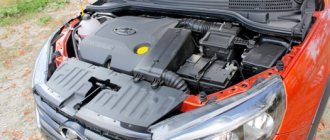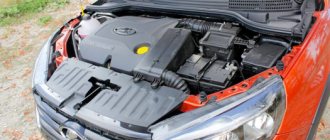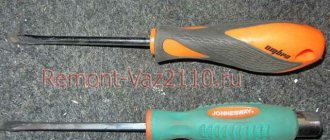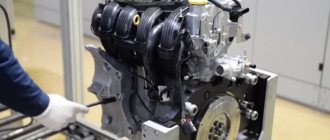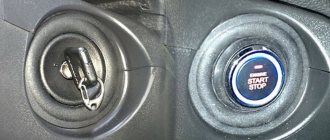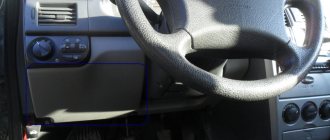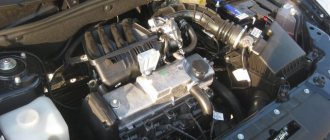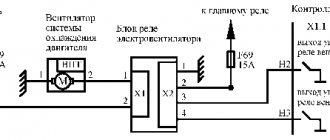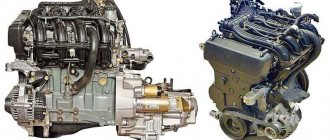Since the appearance of the VAZ 21083 engines, the design of the cylinder block has not differed much and, in fact, the same engine from Priora, which has the index 21126, has 90% similarity with units from the VAZ 2108. Since then, many owners have constantly argued about the resources of front-wheel drive engines VAZ cars, and each, as it happens, has its own truth.
As for the old 8-valve engines, which had a volume of 1.5 (2111) or even 1.6 liters (11183, 21114), they can be called the most successful and trouble-free. The design of the timing mechanism and cylinder head was designed in such a way that in the event of a timing belt break, the valves did not meet the pistons, and accordingly there were no negative consequences as a result of this breakdown. You could even safely throw on a new belt on the road and go. If you travel often, then you just need to buy tickets for the bus.
As for new engines that have 16-valve cylinder heads, with the exception of 21124, in these cases a broken belt leads to serious consequences and, most likely, to considerable repair costs. Cases of not only bent valves, but also damage to the piston group: cylinder walls, pistons and even connecting rods cannot be ruled out. In this case, the repair may turn out to be almost equivalent to the cost of the power unit.
What kind of mileage can the Priorovsky engine withstand?
Taking into account many factors, the mileage and actual service life of VAZ 21126 engines may vary greatly. There have been many cases when, after 40 thousand kilometers, an almost new car had a problem with oil consumption, more than 1 liter per 1000 km, which is unacceptable.
After opening the engines, it turned out that the pistons in the cylinders not only had different groups from A to C, but in the literal sense of the word they were practically hanging out in the block. This is why many people experience a strange sound when running a cold engine, somewhat similar to the operation of a diesel engine.
But it is also worth noting that there are many more cases with a really high resource. For example, the average mileage of engines sent for repair at Priors exceeds 200 thousand kilometers. Of course, this cannot be considered a benchmark, but it is quite a good resource for a VAZ engine. There are many cars with mileage of under 400 and even 500 thousand that have never been repaired during these miles. In this case, most likely the engine is already reaching its end, consuming oil and gasoline, pulling poorly, etc. but nevertheless, this suggests that if you are lucky, and in addition you carefully operated the car, then you can achieve similar results.
Leave a reply Cancel reply
You must be logged in to post a comment.
Each power unit has a certain period of operation without significant intervention in its design, this is the so-called engine resource. This concept applies to all power units, including the Priora engine.
Engine life depends on many factors. Any motor, even without partial intervention, will work for a short period of time. To extend its life, periodic replacement of working fluids and elements is required, which, due to their load, wear out very quickly. Popularly, operations to replace fluids and wearable items are called “replacing consumables.”
The engines that are installed on Priora are considered a new generation of power units mounted on domestic cars. A feature of the first units installed on Priora, in contrast to subsequent generations, was that they had 2 valves for each cylinder. Subsequent engines were already equipped with 4 valves for each cylinder. Each of these engines has certain operating and maintenance conditions.
Operating rules
In order for the Priora engine, regardless of the number of valves per cylinder, to operate as long as possible without major repairs, certain operating and maintenance rules must be followed.
Although the Priora is considered a new generation car, the build quality of the engine remains at the same level. Therefore, after purchasing a new car, it is advisable to immediately go to a service station, or carry out the initial maintenance yourself in a garage.
It consists of checking and, if necessary, tightening all fastening points. Often after the factory, engine attachments and hoses are not tightened enough. This is especially true for power systems, cooling and gas distribution mechanisms. But even after this, it is worth periodically inspecting the power unit for the first few thousand kilometers for leaks.
Dismantled Priora engine
The resource of the power unit greatly depends on the quality of the oil that is poured into it. Low quality oil will not provide the proper lubrication effect, which is especially necessary on surfaces with high friction. Therefore, the use of such a lubricant will significantly reduce the life of the motor.
Since the Priora has an injection power system, you should not neglect the quality of the fuel that is poured into the tank. Gasoline of low quality, as well as with a large number of impurities, will quickly damage the injectors. In addition, the power unit using such fuel will operate intermittently, which will also negatively affect the service life of the engine. But even if high-quality gasoline is poured into the Priora, it will not be superfluous to periodically flush the power system.
The engine life is significantly affected by the driving style of the Priora owner. Aggressive behavior on the highway causes significant damage to all engine systems and mechanisms, especially the cylinder-piston group. Ring wear with this driving style occurs many times faster, which ultimately leads to earlier major repairs of the Lada Priora.
Problem areas of the engine
During operation, Priora owners identified several weaknesses in the engine:
| Weakness | Description |
| Liquid pump (pump) | Often this element fails. And if the driver did not pay attention to the temperature sensor readings in time, pump failure will lead to serious consequences. The power plant will quickly overheat and jam. To bring it back into working order later, you will have to grind the cylinders and replace the piston group. |
| Radiator | Leaks often appear at joints and should be repaired immediately. |
| Timing belt tensioner roller | If, while the Priora engine is running, a hum appears under the hood in the area of the timing belt cover, action should be taken immediately. If the hum appears during a long trip, you can restore the performance of the roller by generously lubricating it. But this won’t help for long; the video will still have to be changed. |
If you ignore the hum, this will lead to the fact that, due to the increased load, the timing belt will fly off or break. The consequence of this will be bent valves and major engine repairs.
Often, Priora owners complain about oil leaking from under the valve cover. This problem can be resolved by replacing the cover gasket.
Priora on throttles
To increase the stability of the engine and the response of the gas pedal, 4 throttle bodies are installed on the intake. The bottom line is that each cylinder receives its own throttle valve and, thanks to this, resonant air vibrations between the cylinders disappear. We have more stable engine operation from bottom to top. The most popular method is to install a 4-throttle intake from Toyota Levin on a VAZ. You need to purchase: the unit itself, make an adapter manifold and pipes, in addition to this you need a nulevik filter, Bosch 360cc injectors, DBP (absolute pressure sensor), fuel pressure regulator, wide shafts (phase over 300), sawing cylinder head channels 40/35, light valves, Opel springs, rigid pushers, spider exhaust 4-2-1 on 51 pipes, or better yet, on 63 pipes. There are ready-made 4-throttle intake kits on sale that are quite suitable for use. With the correct prior configuration, the engine produces about 180-200 hp. and more. To go beyond 200 hp. on a VAZ atmosphere, you need to take shafts like STI Sport 8 and spin them at 10,000 rpm, your engine will produce more than 220-230 hp. and this will be a completely hellish drag cramp. The disadvantages of chokes include a reduction in engine life and this is not surprising, because even city engines on pipes spin at more than 8000-9000 rpm or more, so you cannot avoid constant breakdowns and repairs of the 21126 Priora engine.
Powertrain Maintenance
The frequency of maintenance of the Priora engine by the manufacturer is 15 thousand km. It is recommended to carry out the first maintenance after 3 thousand km. The main attention should be paid to checking all attachment points for attachments. During this same service, the first oil and oil filter change is carried out. If the engine is 8-valve, it is worth checking the valve clearances. For a 16-valve engine, this measure is not necessary, since hydraulic compensators are installed on this power unit. Similar work is carried out after 15 thousand kilometers of the Priora.
After the odometer reaches a value of 30 thousand km, in addition to changing the oil and oil filter, the spark plugs and power system filters require replacement. Often, at this mileage value, the timing tension pulley gradually begins to fail. If the Priora has an 8-valve engine, it will not be superfluous to replace the valve cover gasket.
Signs of the need for internal combustion engine repair
The reasons why the operation of the engine is disrupted are arranged in a small list, starting with refusal to start and ending with floating idle speed (this problem was removed on the 127 “engine”). Not all breakdowns end in capital damage - sometimes it’s enough to add oil, sometimes it’s enough to adjust the ECU settings.
Compression reduction
A decrease in cylinder compression below 16 atmospheres is a bad sign. Such a high limit corresponds to a compression ratio of 11.
If the compression decreases (or vice versa increases), then the “engine” will have to be rebuilt.
Knocks in the engine
Engine knocks can come from several points. These could be hydraulic compressors, timing belt rollers or pins. The knocking noise could also be caused by low oil level. The answer to the question will be given by a thorough detailed inspection of all parts of the unit and checking the oil level.
Blue smoke from the exhaust pipe
The blue smoke that comes from the exhaust pipe appears when oil enters the combustion chamber. It can leak either from the valves or from under the piston. The result is the same: the oil is eaten up and blue smoke pours out of the chimney. Once the leak is located, half the problem will already be solved.
If you don't take care of the timing drive
Emergency failure most often occurs when the timing belt breaks, and then, perhaps, the matter will be repaired by repairing the cylinder head. All this is provided that the motor is plug-in. This can happen as early as 70,000 km.
The Lada Granta and Datsun mi-DO with eight-valve engines that were used by our editorial team broke earlier than the replacement period stated by the manufacturer. In the car service book, replacement is prescribed at a mileage of 75,000 km. In the end - capital! The same effect can be caused by failed timing belt rollers and a cooling system pump.
To avoid problems, I advise you to check the belt at a mileage of 30,000 km and then at each maintenance. Force it to be changed every 60,000 km.
With careful operation and proper maintenance, the engine of a front-wheel drive Lada can travel up to 300,000 km, and only after that the owner will begin to notice a clear loss of performance. However, no one is immune from some problems. For example.
Motor 126 and 127: working life, differences
These engines on Priora had a displacement of 1.6 liters (or 1596 cm3). Optimal for city sedans, the engine size of the Lada Priora gave a good combination of dynamics and consumption: along with very decent acceleration, fuel consumption does not exceed sky-high numbers. Both engines received good marks, because the car behaved perfectly in the city and on the highway.
127 motor - looks like this
In fact, the 126 Priora engine became the first sixteen-valve engine for this model, and the 127 is a modified version, “overclocked” by AvtoVAZ designers. In addition to the same engine displacement, they have other identical characteristics. The in-line type of arrangement of four cylinders provides a simplified design that can be repaired on your own.
The distributed multipoint injection system is involved in creating a good, rich fuel-air mixture (a lean mixture can lead to breakdowns). The cylinder diameter is 82 mm, the piston stroke is 75.6 mm, the compression ratio is 11. The “engines” fall under the Euro 4 standard, they are powered by gasoline with an octane rating of 95.
The 126 engine for the Priora received the following characteristics: 98 hp. (72 kW at 5600 rpm), acceleration to 100 km/h in 11.5 seconds (with manual transmission), city consumption 9.1 l - 100 km (manual transmission), maximum torque - 145 Nm.
The 127 engine for the Priora was upgraded to the following figures: 106 hp. (78 kW at 5800 rpm), acceleration to 100 km/h in 11.5 seconds (with manual transmission), city consumption 8.9 liters per 100 km (with manual transmission), maximum torque – 148 Nm.
The difference may not seem so noticeable, but this is a very small but strong step in design on the part of AvtoVAZ (this is where the change to sixteen-valve “engines” with a volume of 1.6 liters ended). For a car of the Lada Priora class, the engine power was sufficient.
In the same block it is necessary to say about the operating temperature. An absolutely normal operating temperature is considered to be between 90 and 95 degrees Celsius. Further, when the car is being pushed in a traffic jam, is basking in the sun, or for some other reason, but can still work - from 97 to 110 degrees. The engine is slow in places and wears out a lot, but you can still get to your destination. A temperature below 90 degrees is a direct sign indicating that the car has not yet warmed up, and it is better to wait in place until the arrow points to the coveted 80-90 mark.
Operating a car at temperatures above 110 degrees is dangerous because the service life of the engine is noticeably reduced - hot parts undergo very severe wear, overcoming the force of friction.
In general, the service life of the Lada Priora engine with a normal driving style and careful treatment is 200,000 km - after this mark the time comes when the “engine” requires major repairs. AvtoVAZ mentioned the timing belt separately as a recommendation, saying that it needs to be checked every 100,000 km (many car enthusiasts talk about the figure of 50,000 km).
All Lada engines have a problem, and it is related to the valves, which will be discussed further.
Unqualified maintenance
Insufficient quality of air purification, or, even worse, a break in the air filter curtain will reduce the service life of the motor significantly. A heavily clogged filter will not let dirt through, but neither will air. The motor will operate in an off-design mode, and this will not extend its life.
It is important to follow the replacement intervals prescribed in the instructions. More frequent replacement is needed only in steppes and semi-deserts with their eternal dust. I advise you not to buy the cheapest filters - they can let large particles through. A good thing cannot be too cheap. It is best to buy filters from online spare parts stores.
How to extend engine life?
Obviously, a Lada car can be treated very differently. For some, this is a “car” for a couple of years - to get by until the difficult times are over. Someone cares and cherishes their new Vesta. But over time, the attitude towards the car becomes less and less reverent.
Those who want to maximize the life of their cars should:
- Change the oil more often than the regulations require, approximately twice as often.
- Use high-quality consumables and components.
- Do not overload the engine. Both frequent acceleration “to the cutoff” and driving with the pedal “to the floor” at low speeds are harmful.
- Operating the machine with a trailer reduces the service life of the engine.
- Monitor the thermal conditions of the engine. Do not give a heavy load to a cold engine and avoid overheating in summer.
Two trump cards of VAZ engines
1. Cheap repairs. It is due to several factors:
- The design of the engine is familiar to almost any master.
- The tools and equipment needed for repairs are always available.
- Relatively inexpensive spare parts.
2. You can buy a new VAZ engine for a relatively small amount. An eight-valve engine will cost 40,000–50,000 rubles, and a sixteen-valve engine will cost up to 70,000 rubles. At the same time, for example, the most affordable Renault K4M engine, which is installed on the Logan, and earlier on the Lada Largus, will cost at least 104,000 rubles.
Expert commentary
Victor Lelikov,
employee :
Spare parts for VAZ engines are in good demand. This is why there is such a high proportion of substandard spare parts on sale. Such parts come from three sources. The first is cooperative spare parts: their use is especially dangerous. For example, the service life of timing belts can be only a few tens of engine hours. The second source is still encountered defects from the official supplier. This is a spare part that did not pass VAZ technical control, but went on sale. Such parts and components destroy buyers’ faith in the reliability of VAZ cars. Finally, the third source is remanufactured engine parts. But these are becoming less and less common.
Lada Priora
The basic “Norma” package includes a driver’s airbag, ESD, central locking, electric front windows, immobilizer, on-board computer and headlight range control. The “Lux” variation is significantly richer. It includes air conditioning, electric windows on all doors, and an airbag for the front passenger. The main advantage of the luxury package is the presence of ABS and EBD. In addition, it received front fog lights, alloy wheels and parking sensors. Initially, the Lada Priora was produced only with a sedan body, in 2008 a hatchback was released, and a year later a station wagon also went on sale. Finally, last year the plant presented a coupe. By the way, any type of body is given a 6-year guarantee against through corrosion.
